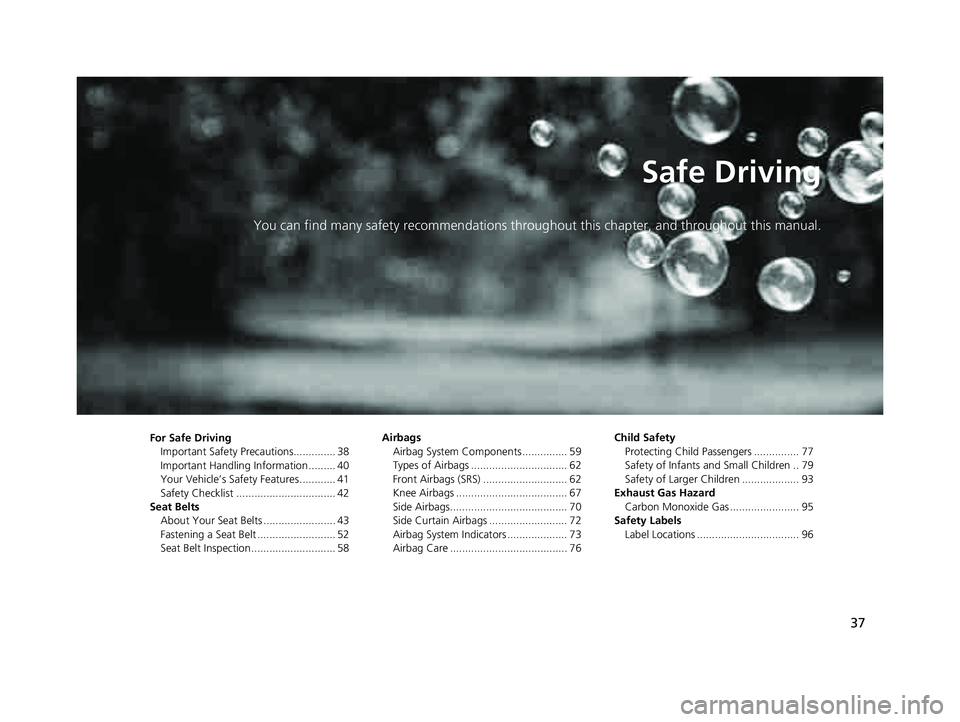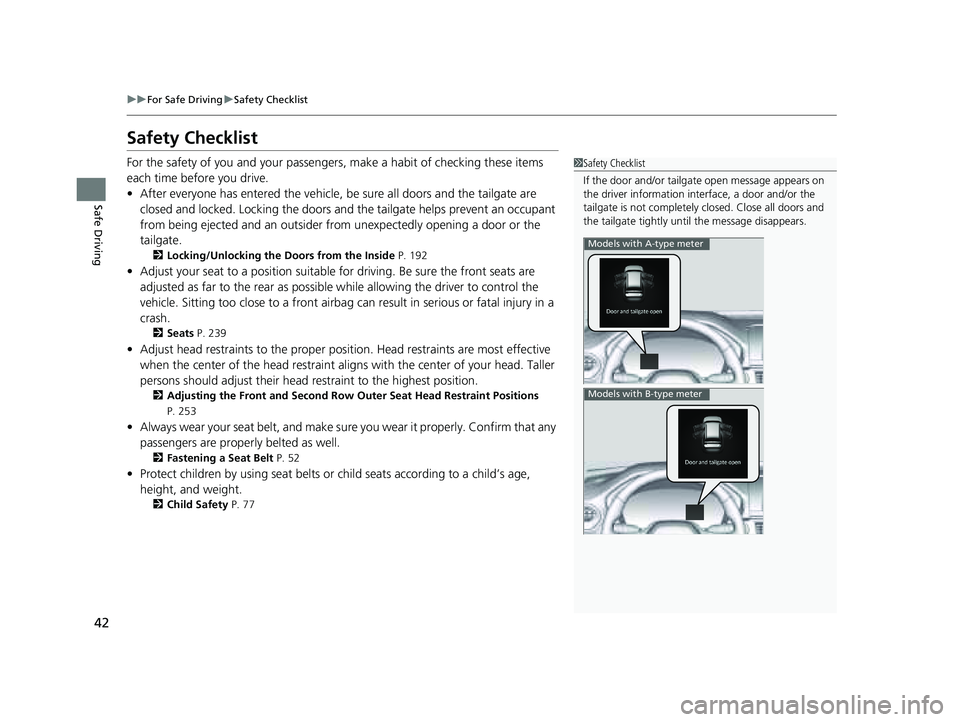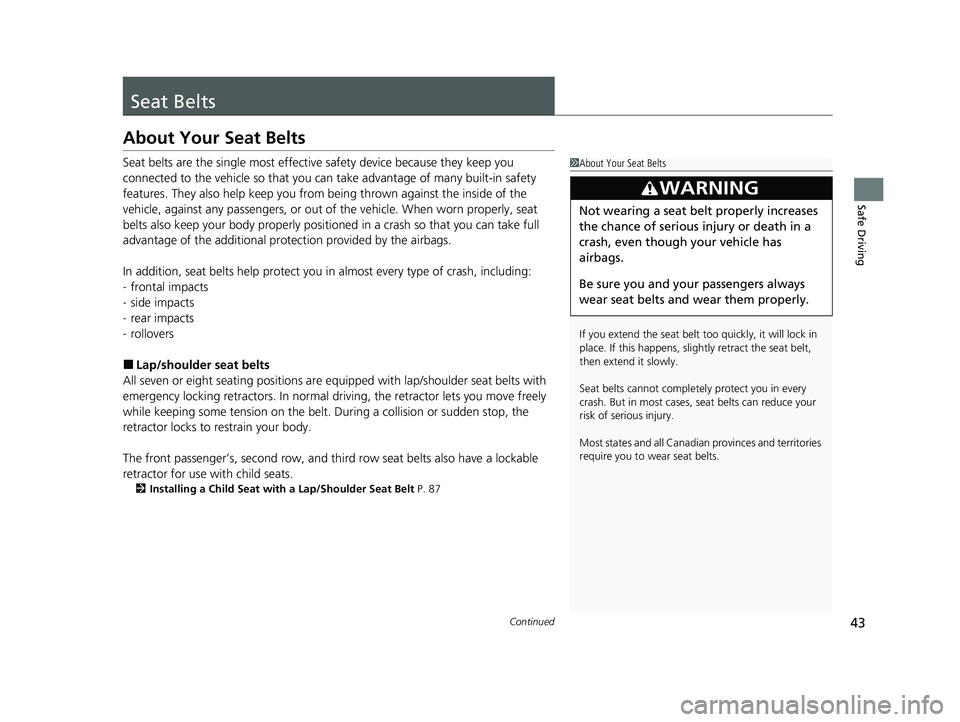2023 HONDA PILOT child seat
[x] Cancel search: child seatPage 12 of 814

11
Quick Reference Guide
❚Accessory Power Socket* (P273)
❚LATCH to Secure a Child Seat (P82)
❚Seat Belt (Installing a Child Seat) (P87)
❚Third Row Seat (P249)
❚Second Row Seat (P243)
❚Seat Belt to Secure a Child Seat (P89)
❚Side Curtain Airbags (P72)
❚Seat Belts (P43)
❚Grab Handle
❚Coat Hook (P266)
❚Walk Away Close Button* (P201)
❚Panoramic Roof Switch* (P213)
❚Map Lights (P261)
❚Sunglasses Holder (P267)
❚Sun Visors (P272)
❚Vanity Mirrors
❚Front Seat (P239)
❚Side Airbags (P70)
❚USB Ports (P293)
❚Second Row Outer Seat Heater
Buttons* (P282)
❚USB Ports* (P293)
❚Cargo Area Light (P262)
❚Seat Belt with Detachable Anchor (P54)
* Not available on all models
23 PILOT-31T906000_03.book 11 ページ 2022年10月31日 月曜日 午前10時26分
Page 16 of 814

15
Quick Reference Guide
Safe Driving (P37)
Airbags (P59)
●Your vehicle is fitted with airbags to help protect you and
your passengers during a moderate-to-severe collision.
Child Safety (P77)
●All children 12 and younger should be seated in the rear seat.●Smaller children should be properly restrained in a forward-facing child seat.●Infants must be properly restrained in a rear-facing child seat.
Exhaust Gas Hazard (P95)
●Your vehicle emits dangerous exhaust gases that contain
carbon monoxide. Do not run the engine in confined spaces
where carbon monoxide gas can accumulate.
Before Driving Checklist (P38)
●Before driving, check that the front seats, head restraints,
steering wheel, and mirrors have been properly adjusted.
Seat Belts (P43)
●Fasten your seat belt and sit upright well
back in the seat.
●Check that your passengers are wearing
their seat belts correctly.
Fasten your lap belt as
low as possible.
* Not available on all models
23 PILOT-31T906000_03.book 15 ページ 2022年10月31日 月曜日 午前10時26分
Page 38 of 814

37
Safe Driving
You can find many safety recommendations throughout this chapter, and throughout this manual.
For Safe DrivingImportant Safety Precautions.............. 38
Important Handling Information ......... 40
Your Vehicle’s Safety Features ............ 41
Safety Checklist ................................. 42
Seat Belts About Your Seat Belts ........................ 43
Fastening a Seat Belt .......................... 52
Seat Belt Inspection ............................ 58 Airbags
Airbag System Components ............... 59
Types of Airbags ................................ 62
Front Airbags (SRS) ............................ 62
Knee Airbags ..................................... 67
Side Airbags....................................... 70
Side Curtain Airbags .......................... 72
Airbag System Indicators .................... 73
Airbag Care ....................................... 76 Child Safety
Protecting Child Passengers ............... 77
Safety of Infants a nd Small Children .. 79
Safety of Larger Children ................... 93
Exhaust Gas Hazard Carbon Monoxide Gas ....................... 95
Safety Labels Label Locations .................................. 96
23 PILOT-31T906000_03.book 37 ページ 2022年10月31日 月曜日 午前10時26分
Page 39 of 814

38
Safe Driving
For Safe Driving
The following pages explain your vehicle’s safety features and how to use them
properly. The safety precautions below are ones that we consider to be among the
most important.
Important Safety Precautions
■Always wear your seat belt
A seat belt is your best protection in all types of collisions. Airbags are designed to
supplement seat belts, not replace them. So even though your vehicle is equipped
with airbags, make sure you and your passengers always wear your seat belts, and
wear them properly.
■Restrain all children
Children ages 12 and under should ride properly restrained in a back seat, not the
front seat. Infants and small children shoul d be restrained in a child seat. Larger
children should use a booster seat and a lap/shoulder seat belt until they can use the
belt properly without a booster seat.
■Be aware of airbag hazards
While airbags can save lives, they can cause serious or fatal injuries to occupants
who sit too close to them, or are not prop erly restrained. Infants, young children,
and short adults are at the greatest risk. Be sure to follow all instructions and
warnings in this manual.
■Don’t drink and drive
Alcohol and driving don’t mix. Even one dr ink can reduce your ability to respond to
changing conditions, and your reaction time gets worse with every additional drink.
So don’t drink and drive, and don’t let your friends drink and drive, either.
1Important Safety Precautions
Some states, provinces and te rritories prohibit the use
of cell phones other than hands-free devices by the
driver while driving.
23 PILOT-31T906000_03.book 38 ページ 2022年10月31日 月曜日 午前10時26分
Page 43 of 814

42
uuFor Safe Driving uSafety Checklist
Safe Driving
Safety Checklist
For the safety of you and your passenge rs, make a habit of checking these items
each time before you drive.
• After everyone has entered the vehicle, be sure all doors and the tailgate are
closed and locked. Locking the doors and the tailgate helps prevent an occupant
from being ejected and an outsider from unexpectedly opening a door or the
tailgate.
2 Locking/Unlocking the Doors from the Inside P. 192
•Adjust your seat to a position suitable for driving. Be sure the front seats are
adjusted as far to the rear as possible while allowing the driver to control the
vehicle. Sitting too close to a front airbag can result in serious or fatal injury in a
crash.
2 Seats P. 239
•Adjust head restraints to the proper position. Head restraints are most effective
when the center of the head restraint alig ns with the center of your head. Taller
persons should adjust their head restraint to the highest position.
2 Adjusting the Front and Second Row Outer Seat Head Restraint Positions
P. 253
• Always wear your seat belt, and make sure you wear it properly. Confirm that any
passengers are properly belted as well.
2 Fastening a Seat Belt P. 52
•Protect children by using seat belts or child seats according to a child’s age,
height, and weight.
2 Child Safety P. 77
1Safety Checklist
If the door and/or tailga te open message appears on
the driver information inte rface, a door and/or the
tailgate is not completely closed. Close all doors and
the tailgate tightly unti l the message disappears.
Models with A-type meter
Models with B-type meter
23 PILOT-31T906000_03.book 42 ページ 2022年10月31日 月曜日 午前10時26分
Page 44 of 814

43Continued
Safe Driving
Seat Belts
About Your Seat Belts
Seat belts are the single most effective safety device because they keep you
connected to the vehicle so that you can take advantage of many built-in safety
features. They also help keep you from be ing thrown against the inside of the
vehicle, against any passengers, or out of the vehicle. When worn properly, seat
belts also keep your body properly positioned in a crash so that you can take full
advantage of the additional protection provided by the airbags.
In addition, seat belts help protect you in almost every type of crash, including:
- frontal impacts
- side impacts
- rear impacts
- rollovers
■Lap/shoulder seat belts
All seven or eight seating positions are e quipped with lap/shoulder seat belts with
emergency locking retractors. In normal driv ing, the retractor lets you move freely
while keeping some tension on the belt. During a collision or sudden stop, the
retractor locks to restrain your body.
The front passenger’s, second row, and th ird row seat belts also have a lockable
retractor for use with child seats.
2 Installing a Child Seat with a Lap/Shoulder Seat Belt P. 87
1About Your Seat Belts
If you extend the seat belt t oo quickly, it will lock in
place. If this happens, sli ghtly retract the seat belt,
then extend it slowly.
Seat belts cannot complete ly protect you in every
crash. But in most cases, seat belts can reduce your
risk of serious injury.
Most states and all Canadian provinces and territories
require you to w ear seat belts.
3WARNING
Not wearing a seat belt properly increases
the chance of serious injury or death in a
crash, even though your vehicle has
airbags.
Be sure you and your passengers always
wear seat belts and wear them properly.
23 PILOT-31T906000_03.book 43 ページ 2022年10月31日 月曜日 午前10時26分
Page 46 of 814

Continued45
uuSeat Belts uAbout Your Seat Belts
Safe Driving■Front seats
The seat belt system includes an indicator on
the instrument panel to remind the driver or a
front passenger or both to fasten their seat
belts.
If you set the power mode to ON and a seat
belt is not fastened, a beeper will sound, and
the indicator will blink. After a few seconds,
the beeper will stop and the indicator will
come on and remain illuminated until the seat
belt is fastened.
The beeper will periodically sound and the
indicator will blink while the vehicle is moving
until the seat belt is fastened.
■Seat Belt Reminder1 Seat Belt Reminder
The indicator will also co me on if a front passenger
does not fasten their seat be lt within six seconds after
the power mode is set to ON.
When no one is sitting in th e front passenger’s seat,
the indicator will not come on and the beeper will not
sound.
The indicator also may no t come on and the beeper
may not sound when the occupant is not heavy
enough to trigger the weight sensor. Such occupants
(e.g., infants and smaller children) should be moved
to the rear seat as a deploying front airbag likely will
injure or kill them. 2 Protecting Child Passengers P. 77
The driver information interface uses colors to aid the
driver in checking the st atus of the passengers.
For the front seating positions:
•Green indicates the seat belt is fastened.•An unfastened gray graphic indicates the seat belt
is not fastened and an occupant has not been
detected.
•An unfastened red graphic i ndicates the seat belt is
unfastened and an occupa nt has been detected.
Models with A-type meter
Models with second row center seat
Models without second row center seat
: Fastened
: Unfastened
: Fastened
: Unfastened
23 PILOT-31T906000_03.book 45 ページ 2022年10月31日 月曜日 午前10時26分
Page 48 of 814

Continued47
uuSeat Belts uAbout Your Seat Belts
Safe Driving
■Rear seats
Your vehicle monitors rear seat belt use. The
driver information interface notifies you if any
of the rear seat belts are unfastened after they
were previously fastened.
In order to encourage th e driver to evaluate
rear seat belt usage, the display appears
when:
• Any of the rear passenger seat belts are
unfastened when the power mode is set to
ON.
• Any of the rear passengers unfasten their
seat belt.
The seat belt reminder indicator blinks and the
beeper sounds if any rear passenger seat belts
are unfastened while driving.
To see the display:
2 Switching the Display P. 125, 154
Models with A-type meter
Models with second row center seat
Models without second row center seat
: Fastened
: Unfastened
: Fastened
: Unfastened
1Seat Belt Reminder
The system will not detect a passenger in the rear
seats who has not fastened the seat belt.
The driver should check the status of the rear
passengers’ seat belts at th e start of each trip and
each time a passenger is seated in the rear seats,
using the driver information interface as an aid.
An alert will sound if a pa ssenger in the rear seats
unfastens the seat belt whil e the vehicle is in motion
or if motion resumes wh ile the graphic is red.
The driver information interface uses colors to aid the
driver in checking the st atus of the passengers.
For the rear seating positions:
•Green indicates the seat belt is fastened.
•An unfastened gray graphic indicates the seat belt
has not been fastened recently.
•An unfastened red graphic indicates the seat belt
was unfastened recently.
The system does not monito r harnesses that are part
of a child seat, the anchor s of the LATCH system, the
installation of a removable seat, or the anchor
buckles of the second and third row center seat belts.
While the system can inform you that a seat belt
buckle is fastened, it ca nnot determine whether the
seat is properly installed, the center seat belt anchors
are in use, or if a child se at is properly installed or
used. 2 Protecting Child Passengers P. 77
23 PILOT-31T906000_03.book 47 ページ 2022年10月31日 月曜日 午前10時26分